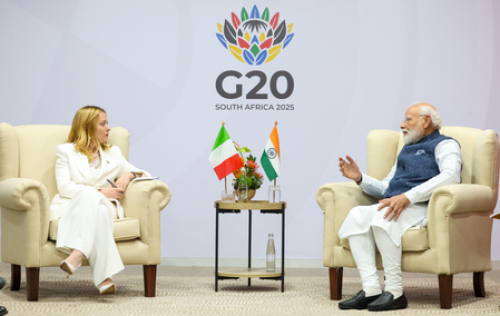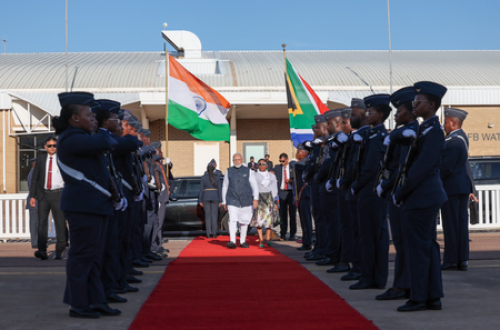By Deepika Bhan
New Delhi, Nov 23 (IANS) A few days ago, Jammu and Kashmir Chief Minister Omar Abdullah remarked that an impression was being created across the country that all Kashmiris were somehow responsible for what happened in Delhi.
He even added that "it feels like a crime to drive a vehicle with a Jammu and Kashmir registration number". His words were not merely an expression of anguish. They appeared to be a calibrated attempt to highlight the divide that mainstream Kashmiri politicians have long leaned on for relevance.
If Omar Abdullah spoke cautiously, People's Democratic Party chief and former Chief Minister Mehbooba Mufti went several steps further. She accused the Central government of creating a "poisonous atmosphere" that, according to her, contributed to the blast near the Red Fort.
While addressing a public meeting in Srinagar, she claimed that the Centre's actions had pushed Kashmiri youth onto a "dangerous path".
Mufti's comments were unambiguous: "These people say that everything is fine in Kashmir,” she said, “but the problems of Kashmir were expressed in front of the Red Fort in Delhi."
Such statements from leaders who have helmed the state may sound shocking to those unfamiliar with the Valley's political culture. But in truth, these remarks are neither isolated nor sudden. For decades, a section of Kashmir's political leadership has thrived on duality - one message for Delhi, another for the Valley. This double-speak has sometimes slipped into openly provocative rhetoric, occasionally bordering on anti-nationalism. And therein lies the deeper tragedy of Kashmir: leaders who have shaped the region's destiny have rarely tried to bridge divides; instead, they have often reinforced them.
It remains an uncomfortable but undeniable fact that the old psychological chasm - "us and them", or the belief that India begins only beyond the Banihal tunnel - continues to persist in the Valley.
The abrogation of Article 370 in 2019 did not erase that mindset. It could not, because political, religious, and social influencers in Kashmir have never truly attempted to dismantle such divisive thinking. If anything, they have kept it alive in different forms and tones, depending on political need.
This pattern dates back to the foundational years of Independent India. When Sheikh Abdullah negotiated Kashmir's relationship with India in 1947, he secured significant autonomy, a bargain that shaped the Valley's politics for generations.
The partnership crafted with Jawaharlal Nehru, a co-Kashmiri and the first Prime Minister of India, laid the seeds of separatist politics. It gave rise to a political structure that nurtured a sense of difference rather than integration.
Over time, this autonomy evolved into a narrative of separateness, ultimately becoming fertile ground for separatist politics. What began as political autonomy gradually turned into a narrative of difference, a narrative that many leaders nurtured and exploited over subsequent decades.
By the early 1970s, that narrative was no longer just political posturing. In 1971, an Indian Airlines Fokker F27 aircraft named 'Ganga' was hijacked by Kashmiri separatists Hashim Qureshi and Ashraf Qureshi to Lahore, where the plane was eventually burned.
The hijackers were members of the National Liberation Front, the group that later evolved into the Jammu and Kashmir Liberation Front (JKLF). It was a precursor to the violence that would engulf the Valley years later, and an event that signalled the direction Kashmir’s politics was heading.
But it was the late 1980s that marked a turning point. What began as political alienation exploded into full-scale terrorism, enabled and weaponised by Pakistan. However, separatism in Kashmir has rarely been about the dream of an independent homeland. Its ideological core has been rooted in religious extremism -- the drive to create an Islamic Kashmir and complete Pakistan's "unfinished agenda of partition".
Since 1989, terrorism in the Valley has pursued two clear objectives: to forcibly drive out Hindus and seize their properties, and to establish an Islamist order.
Sadly, both goals have been nearly achieved. The ethnic cleansing of Kashmiri Pandits remains one of the darkest chapters in modern Indian history. The Valley’s demographic reality has changed little even after Article 370 was scrapped; few displaced families have returned.
In the past few years, the Valley has witnessed infrastructural development, renewed tourism, and improved security. But the April 22 Pahalgam attack once again exposed the simmering trouble beneath the surface.
Shockingly, many of those involved were local boys. Now, the same youth who once operated within the confines of the Valley are stepping into the plains of India, seeking to create chaos there as well.
The involvement of local boys exposes how deeply radicalisation continues to simmer beneath the surface. The shock only deepened when one of the perpetrators, Dr Umar Muhammad, released a chilling video before blowing himself up near the Red Fort. Here was a young doctor -- educated, well-off, secure -- justifying suicide bombing as a religious virtue. He was not a product of poverty or deprivation. Yet he succumbed to radicalisation -- a clear sign of how deeply extremist narratives have penetrated the Valley’s social fabric. He was a product of ideological indoctrination.
And that raises a crucial question: why have the political and religious leaders who loudly criticise the Centre done nothing to counter the radical and extremist narratives that spread among Kashmiri youth? Instead of challenging these ideas, many leaders amplify sentiments of alienation and grievance. Instead of reforming mindsets, they reinforce divides for political convenience.
Kashmir is in trouble, and the blame lies squarely with its political, religious, and social leadership. For decades, they have failed to break the psychological barrier of the Banihal tunnel.
Rather than bridging the divide, they have nurtured it -- sometimes for relevance, sometimes for vote banks, and sometimes for sheer political expediency. They have stoked division when healing was needed, exploited fear when clarity was required, and nurtured grievances when responsibility was essential.
What Kashmir faces today is not merely a security issue. It is the cumulative result of years of deceit, duplicity, and failed leadership, whether political or religious.












